Joy to the Content World: Storyblok Brings AI Innovation and Human Connection to JoyConf 2025
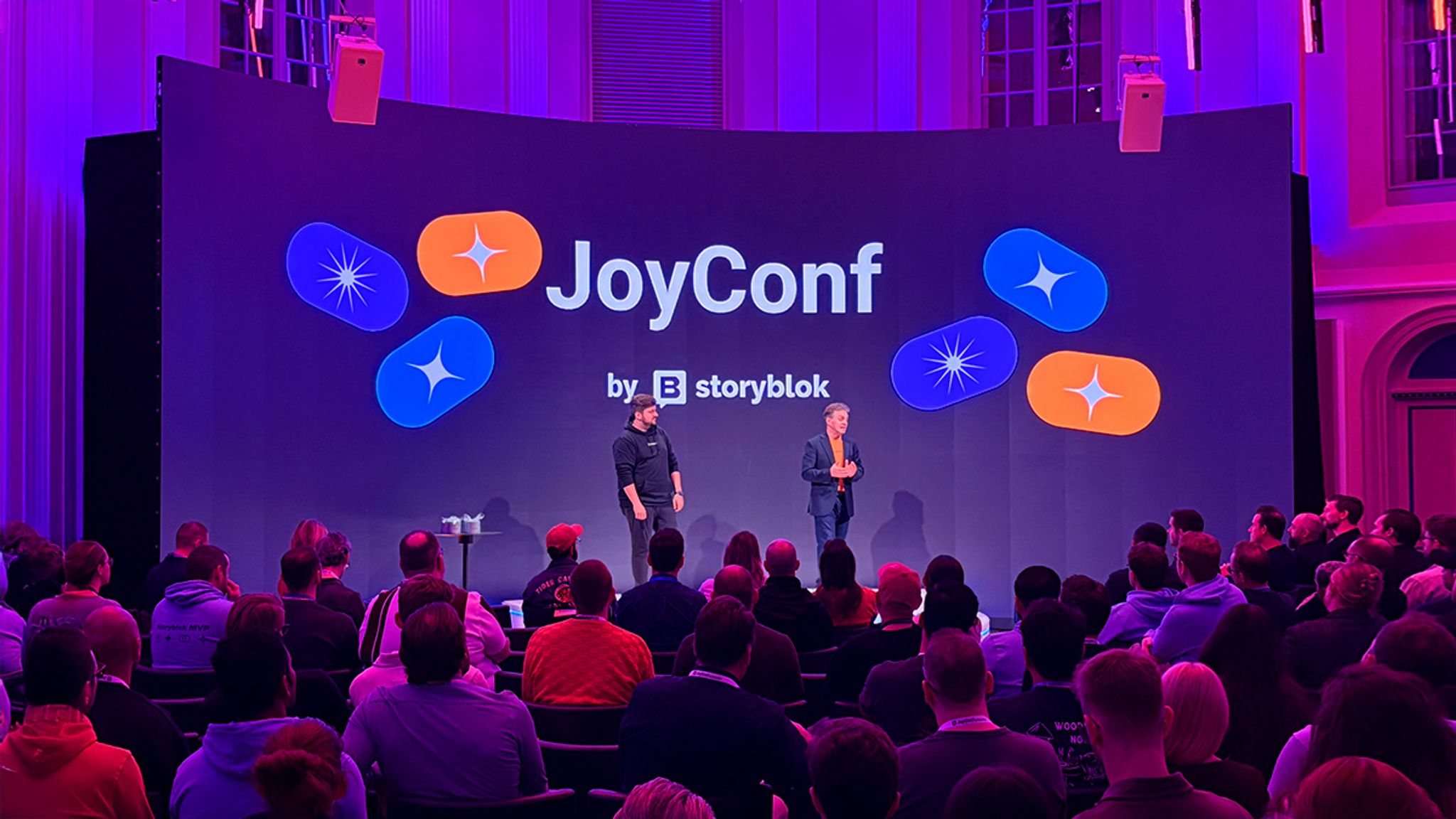
At its first-ever conference, the headless CMS outlined a visionary roadmap for content operations, observability, and personalization, launching new AI-powered features and partnerships to support marketers and developers in the agentic era. But there’s more to this story, and what I saw firsthand was a community that’s passionate about creating – and doing it all with real joy.
Can a technology conference be joyful?
When I first saw the branding for Storyblok’s JoyConf 2025, the headless CMS vendor’s first-ever community event, I was curious. There are lots of things I can associate with joy. But a technology conference?
My question was well-founded. I’ve been to a lot of these shindigs over the last two decades. I have an intimidating collection of lanyards from small niche meetings to monstrous, serpentine experiences like NAB and AWS Re:Invent.
It can be a lot. “Fireside chats” with a thousand people. Workshops and classes. Breakout sessions. The pressure to network and sell, scan or be scanned. Not exactly joyful.
On the flip side, there’s usually fun to be had, even at conferences that feel a little too big or impersonal. Along with the product and feature announcements, there are cool people to meet and parties to hit – some of which have become legendary.
But is it joyful? That might be a bridge too far.
And yet, Storyblok pulled it off.
I guess I shouldn’t be too surprised. I’ve been covering their ambitious trajectory over the last few years as the concept of Joyful Headless™ emerged. They’re now laser-focused on delivering that joy, from its novel Storyblok Labs playground to its exploration of facial coding research to measure and validate the sentiment within their platform. Needless to say, they're all in.
Joy, of course, is a feeling. But Storyblok has managed to bottle it as a product attribute and weave it across its innovation roadmap. In tangible terms, it’s manifesting in the frictionless UX and composable block-based architecture that has made the headless CMS a standout product in the ecosystem. It’s also baked into the company’s culture and its approach to customer success. The intangibles that win hearts and minds.
According to Storyblok, this notion of joy is already having a positive impact on its brand perception. And as the CMS and DXP space continues to remain fiercely competitive – and even AI features become more commoditized – creating with joy could be a decisive factor.
But how did joy become an effervescent presence at this conference?
That’s largely a reflection of Storyblok’s perpetually positive CEO and co-founder, Dominik Angerer, who has grown his scale-up to hundreds of thousands of global users and a healthy $138 million in funding. As he once told me, he’s never had a customer leave because of their product, and that commitment to stellar CX has served him well.
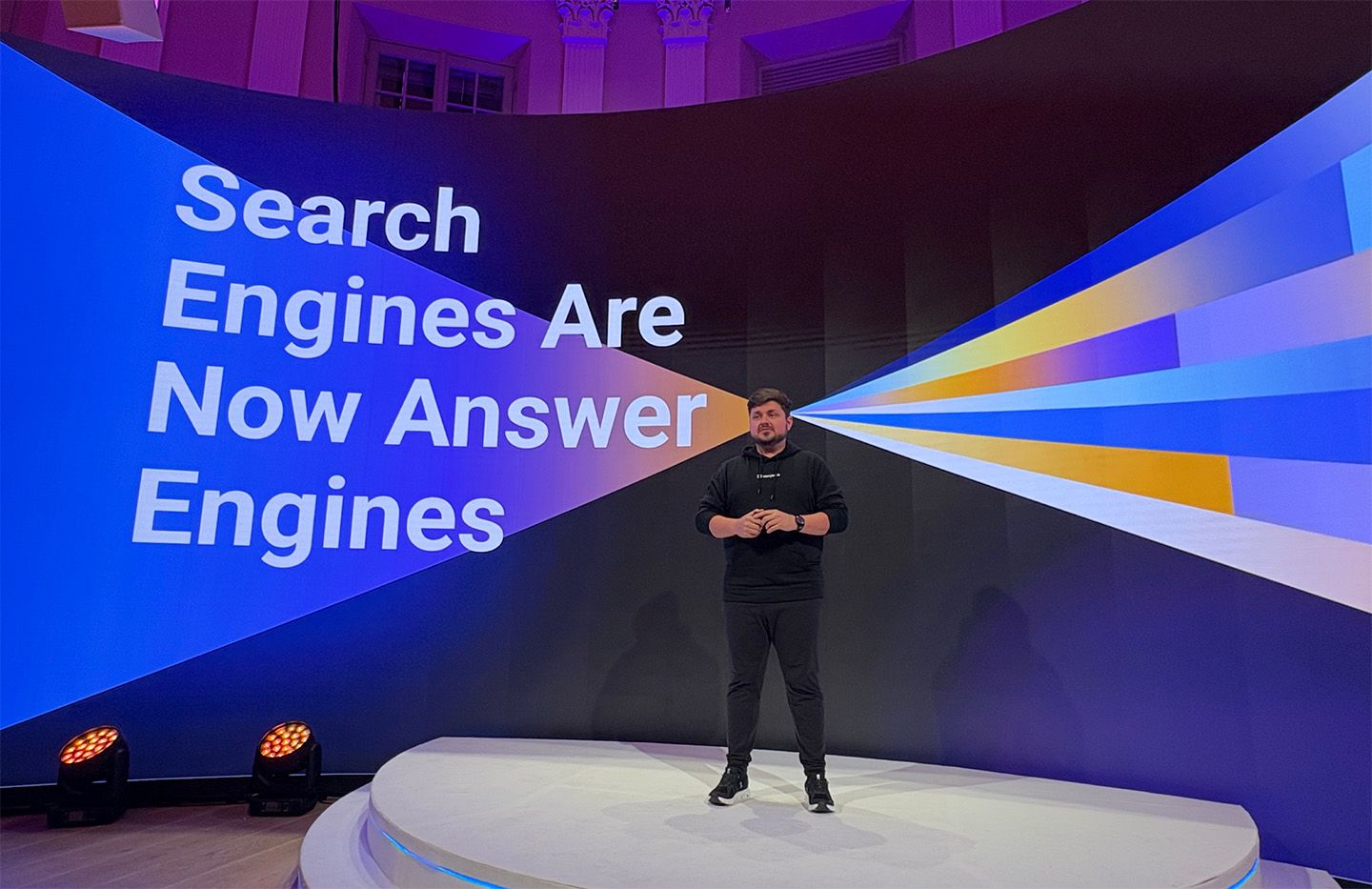
Dominik Angerer, CEO of Storyblok, at JoyConf 2025.
While Dominik might look the part of a prototypical engineer-turned-executive in a slick hoodie – leading an aggressive scale-up on its climb to $100 million in revenue – he’s breaking the Silicon Valley mold. His brilliance is outweighed by his compassion, gratitude, and a truly humble nature that inspires a global staff of almost 300 to create every day with (you guessed it) joy in their hearts.
That’s not hyperbole. I’ve known Dominik for several years and experienced his joyful temperament firsthand. And everyone I’ve ever spoken to about his leadership style has said the same thing: He’s the real deal.
If Dominik has done anything well as a leader, it’s setting an example for his team, all of whom created an undeniable vibe at JoyConf. For starters, the atmosphere was welcoming. There were as many hugs as handshakes, and the enthusiasm was palpable. Fueled by this energy, it felt less like a parity event and more like the beginning of a meteoric rise for a super-charged startup.
And the vibe was infectious. I spoke to numerous agencies, partners, and customers, some of whom were sponsoring the event. They largely conveyed excitement and fervor for what Storyblok is doing and where it’s headed.
The location was also another key factor in the joy equation. The conference was held at the Felix Meritis in Amsterdam, an inspiring historical venue that opens up to the incomparable beauty of the canal belt. Originally commissioned by an intellectual society, the storied structure provided a unique gestalt at the intersection of the past and the future, wrapped in a vibrant and creative city.
OK… but all that joy seemed at odds with the reality we’re facing. Traditional search traffic is declining at an alarming rate, and users are turning to answer engines like ChatGPT at a breakneck pace. The shift in the buyer’s journey is happening now – and brands are looking for a safe harbor.
JoyConf provided a kind of communal hope in the face of these challenges. The substance of the event’s agenda provided not only innovative new tools like Storyblok FlowMotion and Storyblok Strata that are harnessing the potential of AI, but practical sessions that covered everything from spontaneous CMS migrations to dev workshops on designing usable AI features.
The lure of JoyConf clearly resonated. With 420 attendees on the ground – and one-day roadshows planned in New York and Los Angeles next month – Storyblok is leveraging this in-person format to showcase innovation and signal its intention to be a contender in an ultra-competitive market of CMS and DXP choices.
That last part is critical. Right now, both categories are evolving as vendors reposition and embrace new monikers. It’s a dance we’ve seen before, but AI is adding a steroidal cream as marketers look for new ways to translate and differentiate value. This also risks confusion as buyers struggle to understand how to evaluate tools in the AI era.
Case in point: I’ve heard from multiple enterprises about the challenges of selecting platforms with built-in AI features and the sizzle of agentic potential. Will it all really work? How do you compare these capabilities across the vendor landscape?
This is also compounded by the growing perception that AI isn’t paying off for many organizations. In fact, according to recent research from MIT, 95% of gen AI pilots are failing – so separating the hype from the hope has never been more crucial.
All that aside, I’ve seen AI making a valuable impact in the platforms I cover. But even as its competitors adopt new acronyms and positions, Storyblok is remaining steadfast in its intention to remain a content management system – and enhance value through new features that harness AI while doubling down on partnerships that leverage its composable posture.
I came to JoyConf to hear about the future of content and CMS from an exciting vendor with wind in its sails. But what I wasn’t prepared for was how real the joy was. And that feeling – that sense of being inspired by what’s possible – is all about people. As Dominik eluded during his keynote, “We’re turning content into connection, brought together by humans. Not just AI.”
For the company’s CEO, this event was more like a community homecoming, and he was admittedly nervous about its success. Before he started Storyblok, he was marshalling a small-scale gathering called ScriptConf in Linz, Austria, which grew out of multiple meetups. The JavaScript-focused confab informed him about what he wanted to see materialize at JoyConf.
“I always wanted to get people together in a community way, where it’s not just a selling or a corporate event doing the boring stuff,” he told me. “There’s enough boring stuff out there, and we didn’t want to create JoyConf to be just another tech event on your calendar.”
Watch this video, and you’ll see how genuine his joy really is:
There’s a lot to unpack, but there are six big things that really stood out for me at this conference. I’ll be sharing additional interviews over the coming weeks with some customers and partners, but here’s my deep (but joyful) dive on JoyConf 2025.
1. AI is shifting the buyer’s journey, and Storyblok is helping brands future-proof for what’s next
One of the most sobering moments during Dominik's opening keynote was this number: 15%. It stared down from the presentation screen like an ominous specter, a symbol of just how much search traffic has declined this year.
In fact, the numbers are even worse for major news sites. A recent New York Post article reported that of the top 50 news domains, 37 suffered YOY traffic declines, with some nosediving by as much as 40% since last May.
“Something has changed,” Dominik said, referring to the rise of answer engines – ChatGPT, Perplexity, and Gemini – as the new search engines. “Welcome to the new buyer’s journey.”
It’s true: This paradigm of zero-click searches is wreaking havoc for brands, with 59% of all searches on Google now resulting in dead ends. As such, marketers are operating in the dark without the ability to track clicks and attribution.
As Dominik outlined, Storyblok is ready to help place a brand’s content in these new engines with the right mix of tools. From a competitive standpoint, they’ve been adding AI features for quite some time, specifically around automating mundane tasks. But as Dominik explained, they were intentionally patient and methodical when it came to enhancing answer engine optimization.
“AI slop was created at scale,” he said, pointing to content quality as a central challenge. “We had our solution ready, but we wanted to support a foundation of quality. It will always outpace quantity and allow you to rank better on Google and the AI search engines.”
To solve these existential problems, Storyblok is squarely focused on three key pillars. First, they're enhancing content operations in meaningful ways. New features will help marketers automate all the tedious stuff – things like ALT tags, metadata, and translations – so they can focus on creating quality content. Meanwhile, developers will be empowered to ship faster than ever with tools like Storyblok Blueprints, which are production-ready accelerator kits that can be customized at will.
The second is observability. This is a word I’ve been championing at conferences for the last year, and it was gratifying to see it rise as a central theme. We have more content than ever, and less visibility into any of it. As Dominik explained, Storyblok is providing an insider view, turning chaos into clarity.
Finally, the combined power of insight is unlocking the promise of personalization, which continues to be the “Holy Grail” for marketers and brands. Observability is providing the hyper-contextualization needed to make personalization work in a more meaningful way, where it truly understands context.
We go even deeper here:
As Dominik stated, the new features announced at JoyConf are positioning the platform as “the single source of truth for all of your content.” And when you can trust that your content is healthy, it amplifies your performance in AI search and other channels.
“And the structured, headless approach to content that we’ve had since the very beginning means that your content is ready to be visible and succeed no matter what happens next,” he said. “It’s why you can start thinking of your CMS as your Confidence Management System.”
2. Storyblok FlowMotion promises to supercharge workflows and orchestrate AI agents at scale
One of the bigger product announcements at JoyConf was for Storyblok FlowMotion. The name says it all: it sets your workflows in motion, providing an automation and integration layer that’s as smooth as butter. And in keeping with Storyblok’s reputation for slick, frictionless UX, it’s designed with usability in mind.
FlowMotion is anything but slow motion. It provides a marketer’s level of visualization with vibe-codey capabilities, allowing users to connect their content across their tech stack. But it's also a powerful resource for developers who are focused on complex tasks like migration, allowing you to swiftly drop into the code node to write custom transformations in JavaScript or Python.
Much like the drag-and-drop tools you’ve experienced in everything from Marketo to Salesforce, you can design smart content workflows and even orchestrate AI agents to perform a multitude of tasks. In seconds, you can activate a flow from any Storyblok action to create, update, publish, schedule, or translate content. You can also sync with systems like DAMs, trigger notifications, and even route content for review and approval. And this is just scratching the surface.
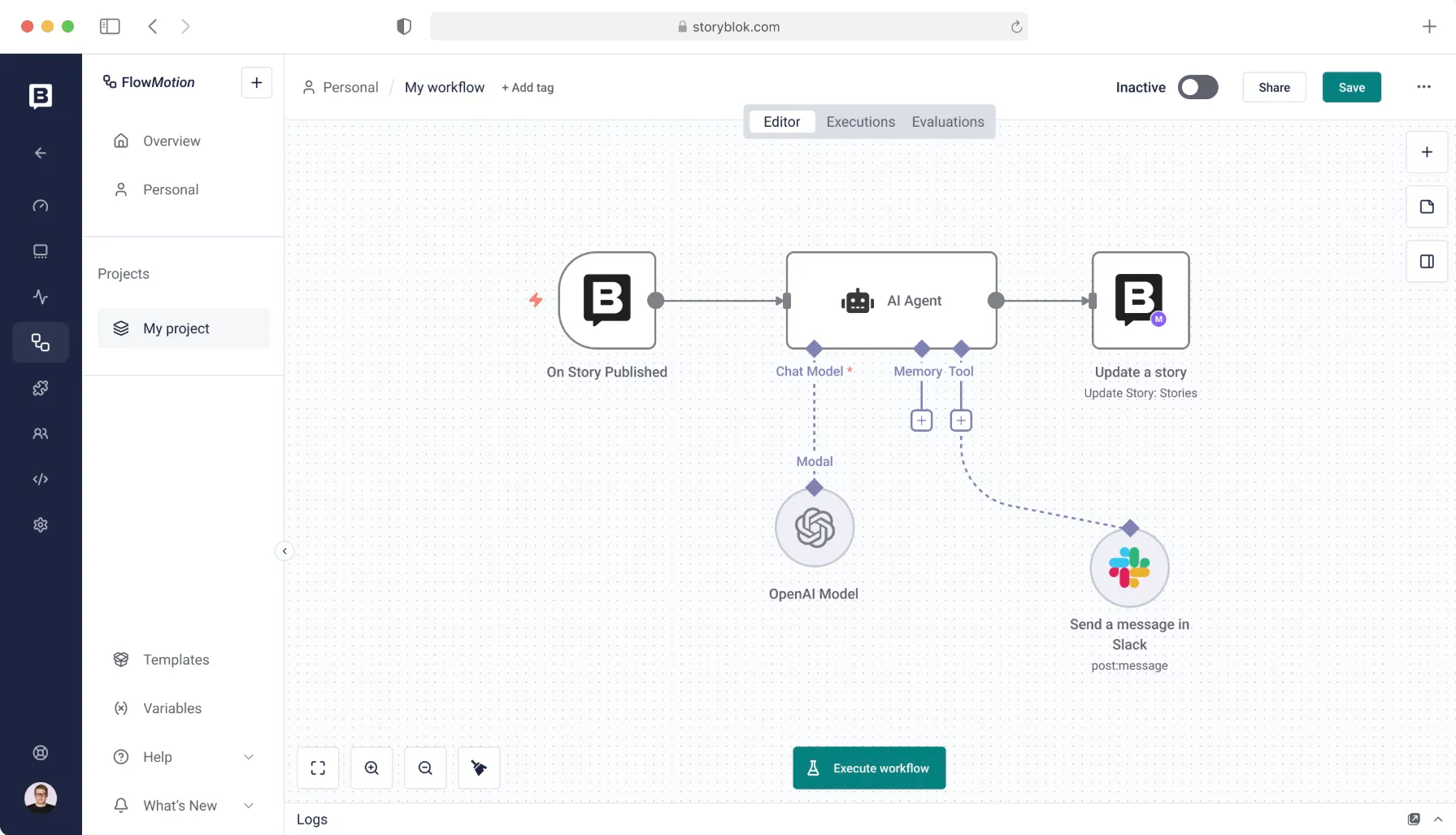
Storyblok FlowMotion. Source: Storyblok
Behind the scenes, FlowMotion is powered by n8n, one of the more popular and extensible AI workflow builders on the market (Lindy is another). Trusted by global brands like Microsoft, Vodafone, and Wayfair, n8n has attained a solid reputation for its drag-and-drop capabilities, as well as its off-the-shelf software integrations – allowing users to connect with over 500 enterprise tools and platforms like Slack and MailChimp, and nodes that govern functions like cron jobs, web hooks, and more.
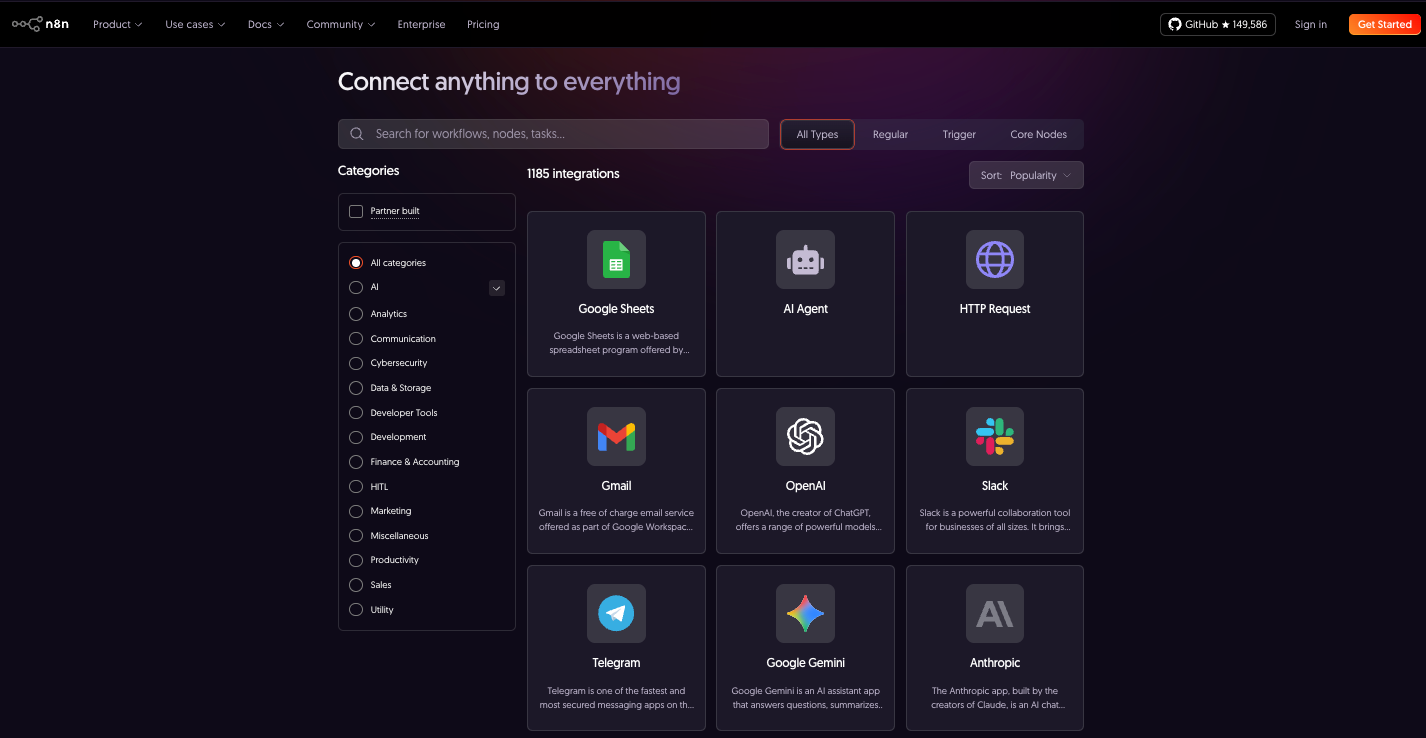
n8n offers hundreds of integrations. Source: n8n website
While FlowMotion can handle standard workflow use cases within Storyblok, it’s a solid foundation for leveraging AI agents to automatically perform a wide range of tasks – something enterprises are keenly interested in. n8n provided the ideal solution for rapidly adding these features using proven technology that also meets rigorous compliance benchmarks like GDPR and AICPA SOC.
Samuel Snopko, Storyblok’s Head of Product, explained to me how this is delivering incredible efficiencies within the CMS – so it all flows smoothly.
“We got this unique opportunity to work with [n8n] and create integrated parts inside Storyblok,” he said. “Our first clients will be able to really build their own instances, so they’re setting up everything they need in the CMS.”
Because Storyblok is bringing its own nodes to the table, anything from its UI and API can be automated with FlowMotion. This includes translations, app connections, tapping AI models like ChatGPT or Claude, and more. Samuel shares more here:
While other CMS and DXP vendors have introduced their own workflow solutions for orchestrating AI agents, Storyblok is now in the game with a solution powered by a best-of-breed builder, which is a testament to its composability. FlowMotion will be available in Q1 of 2026, but the company pre-selected 25 candidates at JoyConf as part of its beta program.
Storyblok’s VP of Engineering, Sebastian Gierlinger, also explained how users will have the ability to maintain much of n8n’s capabilities, and have access to the growing ecosystem of connectors – making it a fantastic solution for scaling Storyblok’s workflow capabilities.
“We’ll also have some example workflows, so you can see what you need and what is even possible,” he said, describing the onboarding capabilities and the investment in customer success. “I think it’s a good playground to start building.”
It’s still early days with FlowMotion, but the potential is there. I would recommend contacting their product team if you’re interested in a demo.
3. Storyblok Strata brings unmatched intelligence, transparency, and clarity to content ecosystems
Perhaps the biggest announcement at JoyConf was the forthcoming Storyblok Strata, which is targeted for GA sometime next year. That means it’s more visionary than viable at this stage – but the promise could be worth the wait.
One of the great things about Storyblok is its ability to understand content within the CMS based on its context. Strata amplifies that by leaning on a high-dimensional vector data layer to make content more understandable.
Vector databases use a similarity engine to find objects or items that are conceptually tangential, making them ideal for AI applications like semantic search, recommendation tools, and LLMs. By harnessing this resource, Storyblok is providing an added layer of intelligence to enhance personalization.
At this point, Strata is somewhat abstract. In fact, Storyblok is lining up five initial partners to prove out marketable use cases. In one example, Dominik explained how he bought a refrigerator, and after the purchase, continued to receive marketing messages for refrigerators.
Annoying? Yes. But more importantly, an example of how personalization at scale misses the mark without added context.
“We thought about how we can solve this problem and raise the bar for it,” Samuel said. He explained how Strata could associate the user’s behavior with other activities that leverage context. For example, instead of offering more fridges to a prospect, you could expand the scope to other appliances as part of a potential kitchen remodel or a new home purchase.
Strata will act as the base layer for Storyblok’s personalization and also connect with FlowMotion’s workflow capabilities to enable greater automation. In this sense, AI is being woven across Storyblok’s expanding ecosystem of tools to create more efficiency.
But there’s something more happening with Strata that could potentially transform the value of personalization and open it up to a wider range of organizational applications. Mark Wheeler, Storyblok’s CMO, gave me some ideas that Storyblok is already pondering.
“There’s a whole array of use cases that marketing organizations can now think about,” he said. “Your hub of content is not just about serving a website anymore. It has the potential to serve a multitude of potential business applications.”
As Mark described, Strata could streamline the development of internal tools for things like sales enablement. For example, a user could run a query based on a number of factors for a prospect, things like their specific technology requirements or broader market challenges. In seconds, Strata will comb the vast amount of data in your Storyblok CMS and create tools like slide decks and other resources.
Mark drilled into some imaginative use cases with me, and he sees a fascinating horizon:
Strata is certainly ambitious – and could reshape the role of Storyblok’s CMS as an engine for personalizing experiences in a variety of channels. Right now, the solution is in its early phases, and their product team is taking a small cohort of customers through testing and optimization. The hype is there, and in my conversations with agencies and customers at JoyConf, there was a clear eagerness to see a tangible product. If you’re ready for more, you can request early access.
4. New partnerships with Netlify and OtterlyAI will provide faster delivery and enhanced visibility in AI search
Along with the core product announcements, Storyblok also showcased two new partnerships that promise to accelerate content deployment and tackle the challenges of monitoring content performance across AI search engines.
The addition of OtterlyAI and Netlify partnerships will solve key marketing and development challenges for Storyblok’s users, but they’re also delivering critical efficiencies from a business perspective. Right now, Storyblok customers with Premium and Elite Storyblok plans can add these features with no separate contracts and no additional vendors to manage.
OtterlyAI
First, let’s talk about OtterlyAI, the brainchild of Storyblok’s former VP of Marketing, Thomas Peham, and co-founders Klaus-M. Schremser, and Josef Trauner. The triptych of tech veterans assembled last year to launch the startup, which gained early attention as a disruptor in the burgeoning GEO (Generative Engine Optimization) space.
I’ve known Thomas since his tenure at Storyblok, where he helped shape the company’s marketing strategy and ride it to a successful $80 million Series C in 2024. He’s the rare blend of marketer and technologist that understands the long game – and how to build for it.
Great content misses the mark if AI can’t find. As Dominik pointed out in his keynote, there’s been a precipitous decline in traffic this year, thanks to the rise of answer engines. Enterprises are struggling with the shift in the customer journey, leaving them with a black box when it comes to their brand and content performance. By 2028, Gartner predicts it could drop by 50% or more. Yikes.
Now, you can shine a light on these dark corners with Storyblok’s Content Observability through OtterlyAI. I’ve used the tool first-hand, and it is, indeed, otterly awesome. The platform’s easy-to-use, highly visual UX shows you exactly where your brand appears across ChatGPT, Google AI Overviews, Gemini, Perplexity, and Copilot — helping you measure, improve, and own your visibility in AI search.
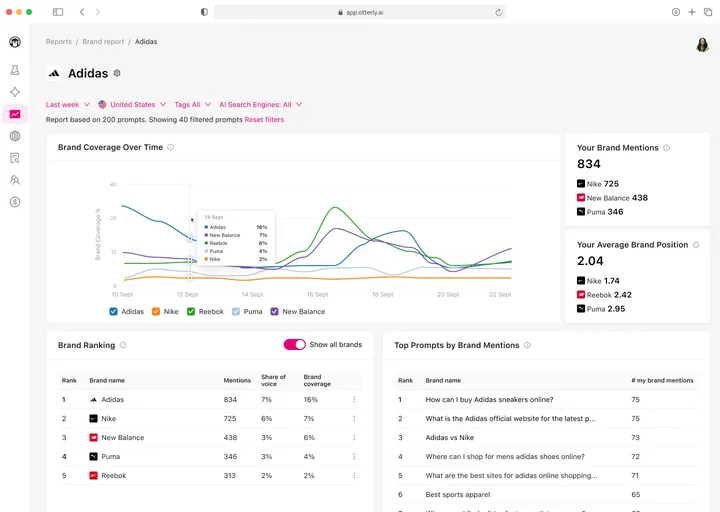
OtterlyAI monitors your content performance across the leading answer engines. Source: Storyblok website
I did a thorough review of Otterly earlier this year, drilling into its capabilities. For marketers, it’s a godsend, enabling teams to enhance their content strategy by uncovering key signals that shape how their content is being discovered and consumed. According to Thomas, 95% of OtterlyAI customers see measurable results within their first month of monitoring, bringing real value to organizations.
“AI is becoming a boardroom conversation,” he said. “But most content teams have no idea about performance.”
The Otterly partnership is a sharp move, reducing the friction for users and brands to harness the features by simply activating Content Observability as part of their Storyblok plan. According to Thomas, the partnership happened organically, and given his history with the company, it provided a more efficient pathway for combining their powers.
While this is an intriguing first step, I think we can forecast an evolving feature set that taps Otterly’s capabilities, specifically as it relates to harnessing content at the headless CMS level. “That's the place where marketing teams create content, publish content, organize it, review it, and so on,” Thomas said. “Imagine having analytics on how your content is performing from a web perspective, but also from an omnichannel perspective.”
Netlify
It’s impossible not to like Matt Biilmann. Just watch him on stage and you’ll get it. At JoyConf, the Netlify co-founder and CEO brought a calm charisma to his presence, rendering the existential challenges of AI into a story that’s both whimsical and blossoming with opportunity.
Earlier this year, I interviewed Matt about his visionary concept of Agent Experience, or just “AX” – which is not his first foray into coining prolific and even hegemonic industry terms (Remember Jamstack? That was him, too). It was an epic conversation that treaded into the white-hot waters of agentic AI, a topic that became the undercurrent of “The Composable Conference” – the MACH Alliance’s signature event – in April.
In the scope of Matt’s presentation, we got a taste of how Storyblok’s block-based content will act as a real-time context engine for agents, and how open standards and the proliferation of Model Context Protocol (MCP) are already powering what Matt called “agent-friendly” sites. He also reinforced some actionable strategies for enhancing web experiences that serve both humans and agents.
One thing I love about Matt’s optimism is his take on the future of development, and where vibe coding intersects. He leaned in on this during his talk at JoyConf, explaining how our entire understanding of the field will evolve.
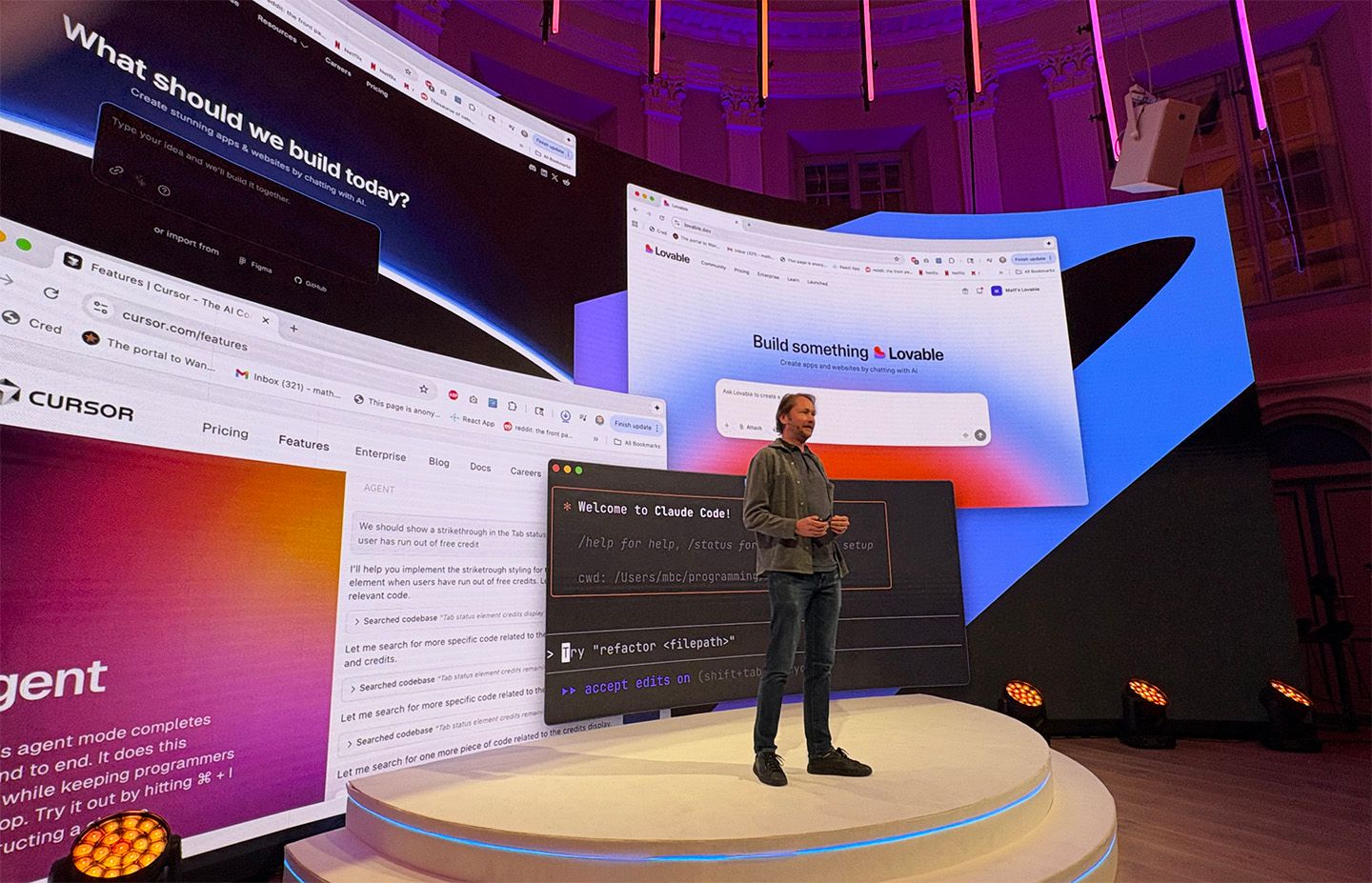
Matt Biilmann, CEO of Netlify, on stage at JoyConf.
“I think we’ll probably get 100 million more developers over the next five years,” he told me. “But as always, what you're developing – and what are developers – will be different.”
While the future looks bright, the present is still unsettled when it comes to scalability. Right now, teams are in the trenches, fighting tools and losing precious time when it comes to shipping software. This battle is being amplified by AI as brands move faster than ever to capture market share across channels.
Netlify is easily one of the best development platforms for deploying and hosting sites and apps with serverless backend capabilities. Now, Storyblok is providing a one-two combo for leveraging content workflows with blazing-fast deployment, automation, and edge delivery.
With its Content Hosting and Delivery partnership, teams can create and publish to live in seconds. With Netlify, there are no servers – and thus no bottlenecks or lost time waiting for releases. You can also create and update via Storyblok’s visual editor with live previews, allowing marketers to make edits in real time and even roll back safely.
As a Netlify user, I’m already familiar with the elegance and efficiencies of the ecosystem. Because the publishing workflows run fluidly between Storyblok and Netlify, updates will trigger fast deployments and revalidation across Netlify’s global edge network via cache refreshes – keeping your content fresh.
One other intangible asset worth noting: It was clear on stage that Matt and Dominik have forged a very friendly (dare I say “joyful”) relationship as scale-up founders and CEOs, which translated into a sentiment of goodwill. It’s not something you would see on a website or in a press release, but both leaders have a longstanding mutual admiration that will likely yield a horizon of future collaboration.
5. New tools aim to enhance content operations
During an interview with Storyblok’s Senior Product Strategist, Derk Majoewskij, I got the download on some of the new buzzworthy tools coming to the CMS. As Derk explained, there are two different directions he’s focused on: getting market intel into their product, and getting their product to the market.
“Every development cycle, we’re looking at a report that I’m building with the intel I’m gathering from the market,” he said. “We have 1,400 ideas – not only feature requests externally, but from our own minds.”
Whittling that down to just a few for JoyConf was part of the challenge, but based on what I saw, there are some solid additions to the Storyblok experience that will impact users.
First, there’s a slick new Enterprise Content Planner that’s focused on supporting brand health and improving generative search performance. It’s clean, super-intuitive, and offers some tight workflow management capabilities that should reduce the gaps in content updates and accelerate publishing. The planner is scheduled for availability before the end of the year.
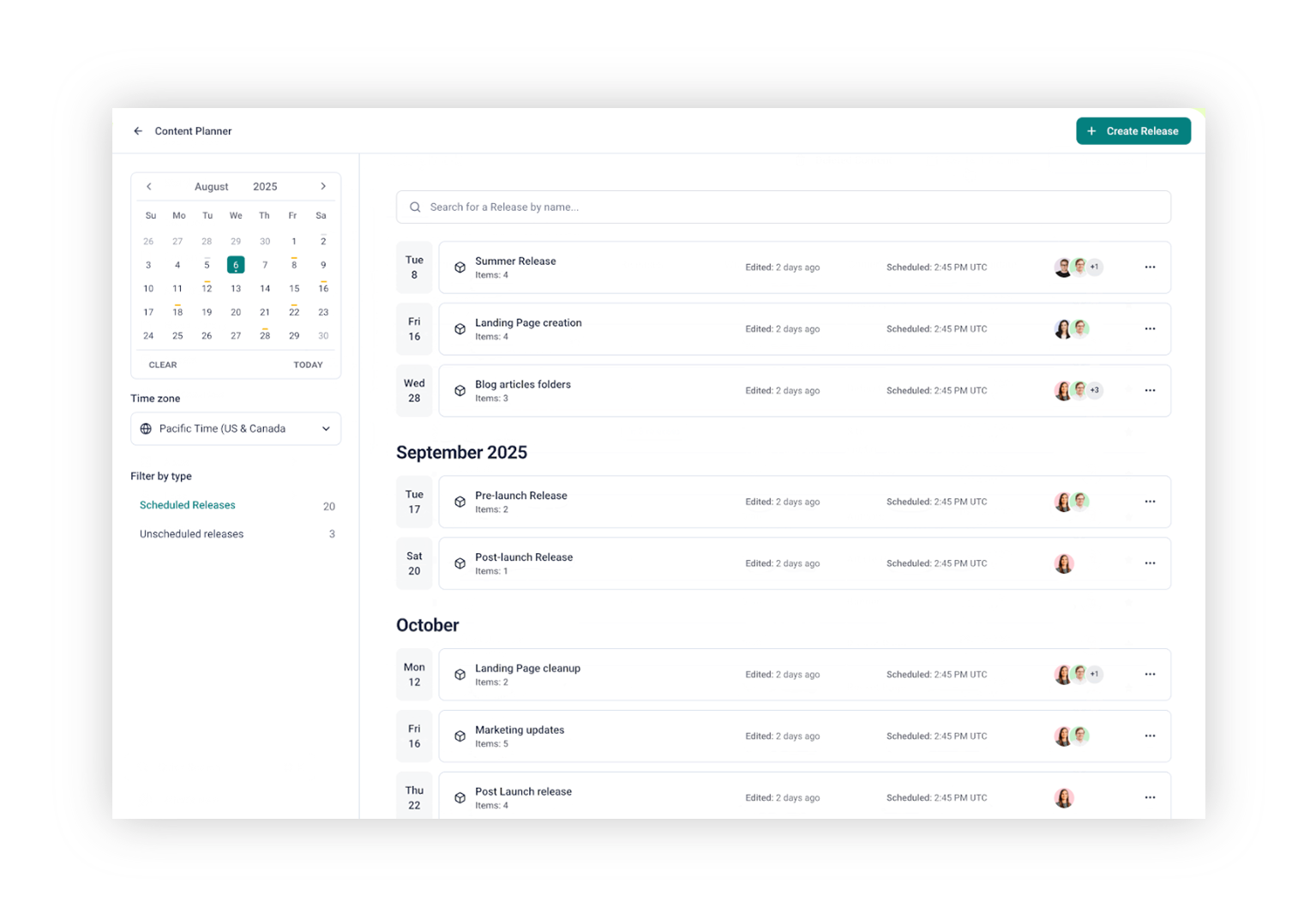
Storyblok’s Enterprise Content Planner. Source: Storyblok website
Figma is a big part of the design and prototyping workflow for many organizations, and Storyblok has introduced a new Figma Plugin that streamlines the translation of visual ideas to code. Users will be able to create Storyblok components directly from Figma design frames and turn them into structured and highly reusable CMS blocks.
In Q1 of 2026, Storyblok will roll out several new features, including a new Global Asset Library, answering the call for more integrated digital asset management capabilities that should render these content elements more reusable across projects and spaces.
There’s also a cool new feature in the works called Environment Spaces, which redefines the extensibility of testing across development, staging, and prod environments without ever disrupting your live content. Pushing a change to a shared space often runs the risk of breaking everything, but now users can be more confident and in control – and even manage versions and releases at scale with native environment management.
Here's a bit from my conversation with Derk, where he shares more on new inline editing, translation features that will ship in the near term, and even some potential out-of-the-box A/B testing features on the roadmap:
6. Customers and partners brought the real joy
Across my conversations with agencies and practitioners between sessions and at the evening reception, there was ample joy in the air. I repeatedly heard just how critical the Storyblok relationship was for builders like Davs Howard of Major Digital – and how it was making a real difference in their work.
José Reboredo Corte, Principal Commerce Consultant at Merkle – a customer experience management company based in Geneva with over 12,000 employees worldwide – shared how Storyblok is the perfect partner for their Merkle Arc CX product.
“Arc is our orchestration layer that we not only use for content projects, but for e-commerce,” he said. “In the unified commerce space, we’re not talking anymore about a single solution to cover all the features. We are integrating more with specific tools to cover specific parts of a project. Storyblok is a fit because it’s API-based.”
I also chatted with innovative leaders like Joubin Rahimi, CEO at Cologne-based Synaigy, a digital agency that focuses on a wide range of projects. As he relayed to me, Storyblok is driving an agentic AI strategy that is key to the future, but it also delivers a tangible UX that helps their shop solve real problems – today.
“Storyblok has a very editor-friendly system, and this is a big difference,” he said. “It’s giving so much power into the hands of the creators, and not back to IT.”
For me, the icing on the headless cake was my interview with Jim Drury, Head of Frontend Technologies at Virgin Media O2 – a joint venture that aims to “upgrade the UK” with a range of mobile and broadband connectivity services.
VMO2 has saved millions in its switch to Storyblok, and Jim’s team has pushed the boundaries of the platform in almost every direction. During our chat, he showed me an example of how his team is rendering three-dimensional objects on their homepage at different angles using a reusable content asset in Storyblok.
Jim’s big announcement at JoyConf was the rollout of the Storyblok React Native Live solution, which builds on the platform’s extensibility and its heritage of visual preview capabilities. Jim’s team wanted to bring that same functionality to React Native, so their content could be previewed directly on mobile devices. VMO2 engineered the solution, and they’ve opened sourced it for the Storyblok community.
“Storyblok has earned so much love in the business,” he said. “It’s at the heart of everything we do. It isn’t just a CMS anymore, it’s a low-code, no-code platform that can be a CMS. But it can also be so much more.”
Jim sat down with me to discuss the genesis of the React Native Live project and how his team has built over 40 applications on Storyblok over the last 18 months:
The ‘joyful’ verdict
One of the jewels in Amsterdam’s crown is its vast and intricate network of canals. They pump through this majestic city like a circulatory system, its arteries reaching far and wide across 165 individual waterways that cover a total of 62 miles. They once provided defense and enabled trade and transit, but their true value was in connecting people.
Much like these canals, the underlying thread of JoyConf was about connection and how content can activate it. And while AI is transforming and automating how we manage content, Storyblok is reinforcing human creativity – and the joyful act of creating – at the heart of its mission.
“We’re building something together,” Dominik said during his opening keynote. “It feels like we’ve been able to build a community and lift each other up.”
That community might be more vital than ever as we face an existential shift in the buyer’s journey and a continued motion towards answer engines. Having tools that can adapt to these new conditions will be essential, and this is where the benefits of observability and content operations are key – along with the right technology integrations and partnerships to complete the AI picture.
But having a fellowship of like-minded builders who share ideas, provide support, or even open source their creations will be a critical asset in the expanding agentic frontier. Building that beachhead takes time, and Storyblok has clearly earned it.
As first large-scale conferences go, this was top-notch. From end to end, the event was well-run, densely packed with high-value content, and curated substantive use cases from customers and partners on both the marketing and development sides of the ledger. But Storyblok also made some key choices with the venue and location that further reflected its culture and European roots.
In terms of the product and feature announcement, JoyConf offered both tangible releases and a hype-worthy roadmap. There were a few voices I spoke to about the abstract promises of Strata, and how it’s still a bit nebulous. But the vision is concrete – and this was a throat-clearing moment for Storyblok’s innovation, and a clear signal of its direction and intentions.
In terms of the partnership announcements, Storyblok is making sage moves to address the very real challenges surrounding GEO while streamlining the persistent challenges of connecting content workflows with faster deployment, automation, and edge delivery. Netlify is also a solid brand that’s associated with bleeding-edge innovation in agentic AI, and being in Matt Biilmann’s orbit is a smart move.
At the same time, JoyConf offered insights from Storyblok’s broader partner ecosystem. This included compelling talks by Marcel Visser of AWS, presenting a new cloud-powered view of retail in the AI age, and Sören von Sebelin of Lokalise, focusing on autonomous localization for modern dev teams.
On the second day of the event, I had a chance to moderate a panel of industry journalists to discuss the evolving role of content and touch on topics like agentic AI. This peek inside the newsroom offered lessons and reflections from Steph Bailey of Sifted, Molly Innes of Marketing Week, and Joe McKendrick – an independent researcher and speaker who writes for both Forbes and ZDNet.
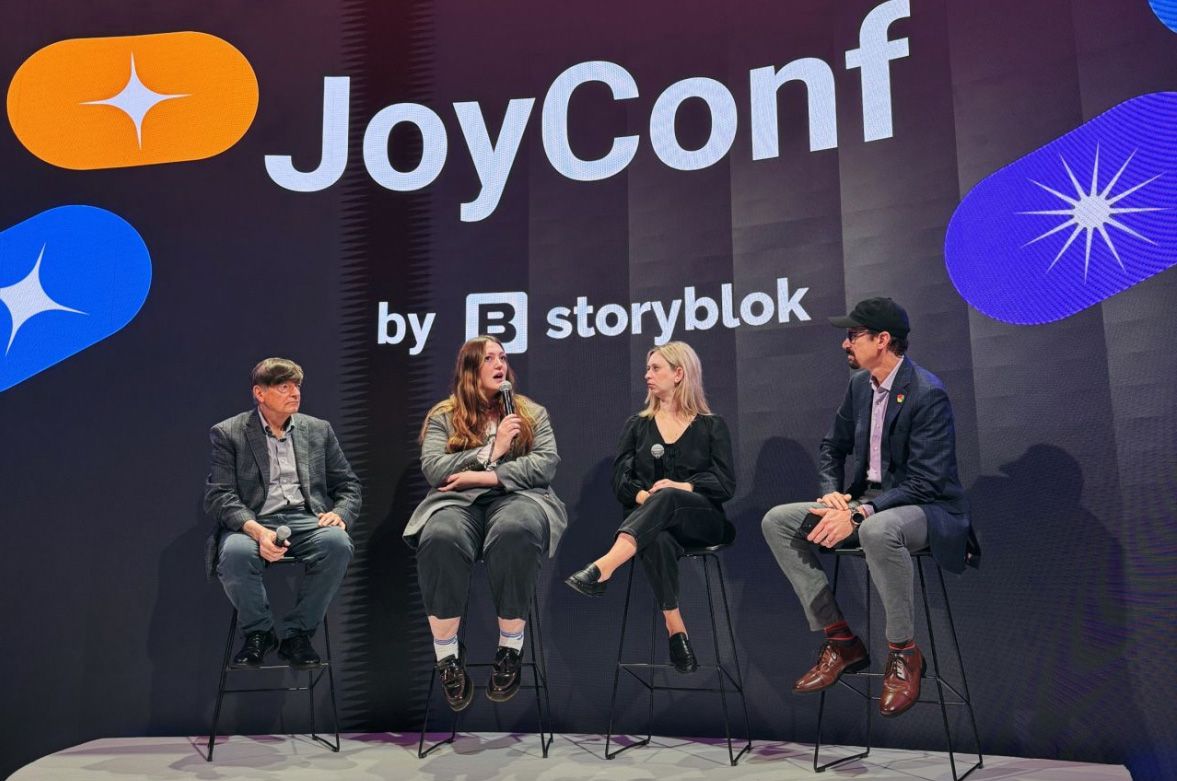
JoyConf journalist panel. Left to right: Joe McKendrick, Molly Innes, Steph Bailey, Matt Garrepy
I give Storyblok a lot of credit for engineering this into the format. It was a great opportunity to relay some of the insights we’re seeing in the technology field, and not just about CMS. My colleagues also shared actionable strategies to help brands break through the noise for media coverage. It was a lively and rewarding discussion.
As Storyblok writes its next chapter, it is redefining what a CMS is for the AI era, from creation to governance to delivery. With so much choice and competition in the CMS and DXP market, they are establishing a clear voice around their AI trajectory and building the right tools and channels to break through.
At a time when so many of the messages in our market sound the same, Storyblok is leveraging its greatest power to build differentiation: joy. More importantly, it’s “walking the talk” and evangelizing that promise – that feeling – in everything it does. From product to partnership. From company to community.
Some might challenge the authenticity of this position, but just ask Storyblok’s customers.
They seem to be singing one verse on high:
Joy to the content world.
Upcoming Events

Storyblok JoyConf 2025
November 4, 2025 – New York, NY
November 6, 2025 – Los Angeles, CA
Join us at JoyConf 2025, where the future of content meets the people shaping it. Built for developers, marketers, and digital innovators, this free conference goes way beyond product updates or yet another strategy playbook. It’s where you’ll get inspired, get real, and get connected – to ideas, to the community, and to what’s possible when you build joyfully. Whether you're building lightning-fast frontends or launching cross-channel campaigns, this is where content becomes connection and collaboration becomes second nature. Come for the talks. Stay for the community. Leave with joy. Save your spot.